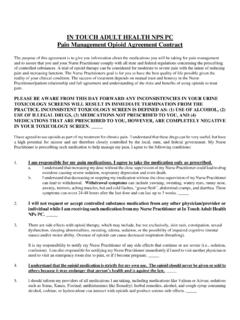Transcription of Safely Discontinuing Opioid Analgesics
1 Safely Discontinuing Opioid Analgesics Author:Lee A. Kral, PharmD, BCPS Editor: Stewart B. Leavitt, MA, PhD Medical Reviewer: Jeffrey Fudin, BS, PharmD, DAAPM Release Date: March 2006 Introduction Severe hurricanes in the Gulf Coast during 2005 caused many hardships for patients and healthcare providers alike. An important concern coming to light during this time of crisis was the inability to obtain prescription medications, in-cluding Opioid Analgesics . Patients with chronic pain and their healthcare provid-ers faced the daunting task of either somehow procuring the opioids or, if this was not possible, tapering the medications to prevent onset of Opioid withdrawal.
2 In response to the crisis in the Gulf Coast, a multi-organization Working Group published Recommendations to Physicians Caring for Katrina Disaster Victims on chronic Opioids (AAPM et al. 2005). The National Pain Foundation also published information for patients regarding withdrawing from medications (NPF 2005). Safely Discontinuing , or ta-pering Opioid Analgesics is not only a concern in times of natural disaster, but an issue that pain services and primary care providers confront daily as they try to balance the benefits and adverse effects of Analgesics . Reasons for Tapering There are many reasons for considering Opioid tapering, both from healthcare provider and patient perspectives.
3 Patients may decide that they wish to stop their Opioid therapy if they experience adverse effects. Opioid rotation is an op-tion; however, patients may be wary to try another agent or may experience in-tolerable adverse effects with certain chemical classes of opioids. Their pain may not be Opioid -responsive, their underlying disease process may have improved as a result of surgery or other interventions, or despite increasing their dose at regular intervals an adequate pain response was not realized. Patients may be reluctant to continue opioids because of a negative social stigma attached to this therapy. In some cases the Opioid may be discontinued due to the cost associated with obtaining the prescription or because a newly assigned medical clinician refuses to provide such therapy chronically.
4 Safely Discontinuing , or tapering, Opioid Analgesics is an ongoing concern, both in times of crisis and on a daily basis. There are many reasons for considering Opioid tapering, such as adverse effects, inadequate pain relief, and medication costs. Kral Safely Discontinuing Opioid Analgesics 2 Providers may engage in tapering an Opioid due to safety concerns. One of the controver-sies in chronic Opioid management is the phenomenon of Opioid -induced hyperalgesia (Chu et al. 2006; Doverty et al. 2001; White 2004), which suggests that in certain patients chronic ex-posure to opioids results in an increased sensitivity to pain. This may occur as early as one month after initiating Opioid therapy.
5 Other potential consequences of long-term Opioid use include hypogonadism and resultant osteoporosis (Daniell 2002; Abs et al. 2000). Serum testosterone levels have been shown to fall within hours after ingestion of a single dose, and low serum levels of testosterone and estradiol are associated with an increased risk of osteoporosis (Daniell 2002; Moyad 2003). Providers also may have concerns about efficacy. If they do not see an improvement in patient function and quality of life, they may feel that the risks of the therapy (as mentioned above) outweigh a questionable benefit. Finally, providers may consider tapering opioids due to patient non-compliance with the medication regimen or violation of the patient s Opioid agreement with the pain management team.
6 Guidance for starting medications is fairly easily obtained from product package inserts and reference books; however, it is more difficult to find information about switching or stopping Opioid medications. Many practitioners, particularly specialists, tend to have their own formulas for managing conversions and tapers; although, there is no single strategy that can be applied to all patients, and each situation must be handled on an individual basis. The most important factor to consider is how acutely the taper or conversion is needed. Detoxification Settings Tapering off opioids (often called detoxification or detox ) may be done within a chemical-dependency treatment setting, specialty clinic, or primary care prac-tice.
7 Protocols vary between institutions and outpatient centers and, depending on how acutely the taper is needed, several options are available: Ultra-rapid detoxification is performed in the inpatient setting under general anesthesia. The usefulness of this method is controversial and is inappropriate for agents that have a long biological half-life ( , methadone). Inpatient detoxification usually employs a fairly rapid tapering protocol in conjunction with behavioral therapy. This setting is considered for those patients who: a) are medically un-stable, b) fail outpatient programs, c) are non-compliant, d) have comorbid psychiatric ill-ness, or e) require polysubstance detoxification.
8 Due to the financial burden of inpatient programs, many facilities have shifted to partial hospitalizations or intensive outpatient pro-grams. Outpatient detoxification commonly employs a slower tapering protocol. While it is common practice to replace short-acting opioids with extended release products ( , MS Contin or Oxycontin ) or one with a long half-life, such as methadone, a taper using the prescribed short-acting Opioid is frequently employed. There is no single protocol that has been proven more efficacious than another and, regardless of the strategy used, the provider needs to be involved in the process and remain supportive of the patient and his/her family.
9 There is no single strategy that can be applied to all patients. Each situation must be handled on an individual basis. Several options are available, depending on how acutely the taper is needed. Kral Safely Discontinuing Opioid Analgesics 3 Duration of Taper The duration of the taper depends on its complexity and the patient s needs. The universal goal is to taper as quickly as the patient s physiologic and psycho-logical status allows. The presence of multiple comorbidities, polysubstance abuse, female gender, and older age are among factors increasing the difficulty of tapering and tend to lengthen its duration. Patients with a long history of taking chronic opioids, or any centrally acting medication involving receptor pharmacol-ogy ( , dopamine agonists, SSRIs) are more likely to experience withdrawal from a taper that is too rapid, and therefore may require a longer taper period to avoid such symptoms.
10 Some patients may have a great deal of anxiety about the potential for increased pain or experiencing withdrawal symptoms. In all cases, it is important to make decisions about tapering therapy on an individual basis. The Katrina Disaster Working Group s recommended tapering schedules are found in Table 1 (AAPM 2005). The VA Clinical Practice Guideline on chronic Opioid therapy also contains suggested tapering regimens for several different opioids, as presented in Tables 2 and 3 (USVA 2003). The VA regimens are quite rapid and are not tolerated by many patients. Unless there is a pressing need for a rapid taper, a slower taper is tolerated much better. Agents Used to Taper Depending on the situation, several options for ta-pering agents are available.





